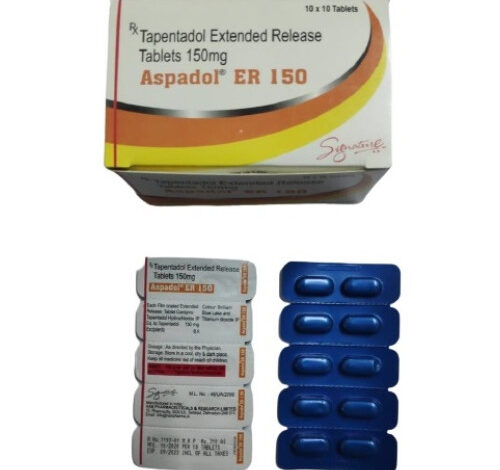Interactions Between Aspadol and Other Medications

Aspadol, with its active ingredient Tapentadol, is a potent pain-reliever prescribed for managing moderate to severe pain. It functions as a dual-action opioid analgesic, targeting the brain’s mu-opioid receptors and inhibiting the reuptake of norepinephrine, enhancing pain tolerance. However, like any powerful medication, Aspadol has a complex profile of interactions with other drugs, which may lead to increased side effects or reduced efficacy. Understanding these interactions is essential for those prescribed Aspadol, as well as for healthcare providers responsible for patient safety.
Understanding Aspadol’s Mechanism of Action
Before diving into the interactions, it is important to recognize how Aspadol works within the body. Tapentadol operates on the central nervous system (CNS) by engaging with opioid receptors to block the perception of pain. It simultaneously inhibits norepinephrine reuptake, which plays a role in pain modulation and mood. This dual mechanism of action makes Tapentadol unique among opioids, offering relief from neuropathic pain and nociceptive pain.
Aspadol 150mg is a valuable medication for relieving discomfort.,It has the potential to be incredibly helpful in treating a variety of pain conditions.,Whether it’s a headache, fever, toothache, cough from cold air, or menstrual pain, Aspadol 150mg can provide relief.,This medication is effective in reducing pain and providing comfort.
Medications That May Intensify Aspadol’s Effects
1. Central Nervous System (CNS) Depressants
Medications such as benzodiazepines (e.g., diazepam, alprazolam) and barbiturates (e.g., phenobarbital) are central nervous system depressants that are often prescribed for anxiety, seizures, or insomnia. When combined with Aspadol, CNS depressants can intensify sedative effects, leading to extreme drowsiness, respiratory depression, and even coma. This interaction can be fatal if not carefully managed.
Similarly, muscle relaxants like cyclobenzaprine and baclofen, which also have CNS-depressant properties, may amplify the sedation and respiratory risks associated with Aspadol. This combination should be closely monitored, with dosage adjustments made to avoid dangerous levels of CNS suppression.
2. Antidepressants
Antidepressants, particularly those classified as serotonin-norepinephrine reuptake inhibitors (SNRIs) like duloxetine and venlafaxine, as well as tricyclic antidepressants (TCAs) such as amitriptyline and nortriptyline, can interact with Tapentadol’s norepinephrine reuptake inhibition. This may increase the risk of serotonin syndrome, a potentially life-threatening condition characterized by agitation, tremors, high blood pressure, and elevated body temperature.
Additionally, monoamine oxidase inhibitors (MAOIs), though less commonly prescribed today, pose a significant risk when combined with Aspadol. MAOIs, such as phenelzine and selegiline, interfere with the breakdown of neurotransmitters like norepinephrine and serotonin, potentially leading to hypertensive crises or severe serotonin toxicity when mixed with Tapentadol.
3. Antipsychotics
Antipsychotic medications, particularly atypical antipsychotics like quetiapine, olanzapine, and risperidone, can also have sedative effects. When taken alongside Aspadol, the combined sedation can be profound, leading to significant cognitive and motor impairment. Additionally, antipsychotics that affect dopamine receptors might complicate the pain-relieving effects of Aspadol by altering how the brain processes pain signals.
Aspadol 100mg is a multifunctional medicine that relieves pain. It can be used with those who are uncomfortable in many ways. The drug’s generic ingredient, tapentadol, is a painkiller that can aid with both acute and severe pain that is only felt momentarily. See your doctor about taking such a medication if you have been in excruciating pain lately. Aspadol 100mg should be used with the understanding that the doctor’s dosage instructions and relevant criteria must be adhered to.
4. Alcohol
While not a medication, it is critical to emphasize that alcohol is one of the most dangerous substances to consume while taking Aspadol. Alcohol magnifies the depressant effects of Tapentadol, increasing the risk of overdose, respiratory failure, and fatal sedation. Patients are strongly advised to avoid alcohol consumption while on this medication.
Medications That Reduce the Effectiveness of Aspadol
1. Enzyme-Inducing Medications
Some medications, particularly those that induce certain liver enzymes, can accelerate the breakdown of Tapentadol in the body, thereby reducing its efficacy. Carbamazepine, a common anticonvulsant and mood stabilizer, induces the CYP450 enzymes that metabolize drugs in the liver, leading to lower concentrations of Tapentadol and diminished pain relief. Similarly, rifampin, an antibiotic used to treat tuberculosis, has the same enzyme-inducing effect, potentially compromising the therapeutic effect of Aspadol.
2. Opioid Antagonists
Drugs that act as opioid antagonists, such as naloxone and naltrexone, can block the opioid receptors that Aspadol targets, thereby negating its pain-relieving properties. These medications are often used in emergency situations to reverse opioid overdoses or in addiction treatment to prevent misuse, but they render Aspadol ineffective in treating pain.
3. Other Opioids
The simultaneous use of other opioid medications, such as morphine, oxycodone, or fentanyl, can either increase the risk of opioid overdose or create a situation where one opioid interferes with the action of another. While it may seem that combining opioids would provide greater pain relief, in reality, this practice heightens the risk of addiction, tolerance, and life-threatening side effects like respiratory depression.
Over-the-Counter (OTC) Medications and Herbal Supplements
1. NSAIDs and Aspirin
Nonsteroidal anti-inflammatory drugs (NSAIDs) like ibuprofen or naproxen, and aspirin are commonly used to manage mild to moderate pain. While these medications don’t interact directly with Aspadol, they do provide an alternative pain relief pathway through the inhibition of cyclooxygenase (COX) enzymes. This means patients may combine NSAIDs with Aspadol to achieve more comprehensive pain control, particularly for inflammatory pain, without additional opioid-related risks. However, caution is still warranted, as gastrointestinal side effects can increase when these are taken in higher doses alongside Tapentadol.
2. St. John’s Wort
The herbal supplement St. John’s Wort, often used for mild depression or anxiety, is a CYP3A4 enzyme inducer and can reduce the levels of Tapentadol in the bloodstream. This interaction lowers the drug’s effectiveness, potentially requiring dose adjustments. Patients should always disclose the use of herbal supplements to their healthcare providers to avoid unintended interactions.
3. Antihistamines
Over-the-counter antihistamines like diphenhydramine and chlorpheniramine, used for allergies or colds, can enhance Aspadol’s sedative effects, resulting in profound drowsiness or impaired coordination. Patients should be advised to limit the use of sedating antihistamines while taking Tapentadol unless absolutely necessary, and they should avoid operating machinery or driving if both are taken together.
Conclusion
Understanding the complex interactions between Aspadol (Tapentadol) and other medications is crucial for patient safety and effective pain management. Given its significant effects on the CNS and neurotransmitter systems, Tapentadol interacts with a variety of drugs in ways that can either enhance its effects or reduce its efficacy. For those managing chronic pain, clear communication with healthcare providers about all medications and supplements is essential to avoid dangerous combinations and to optimize treatment outcomes.





